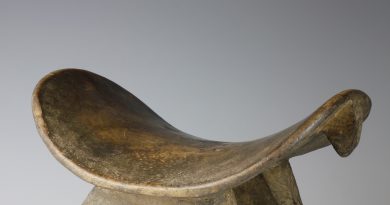A History of Stools
Stools, as a simple, backless seat, have a rich history, evolving from early, portable forms to various styles and functions, with examples found in ancient civilizations such as Egypt and Greece, and continuing through the medieval period and beyond.
Why is a stool called a stool?
Comes from the Old English stol meaning seat for one person, which shares a Proto-Germanic root with the modern German Stuhl, meaning seat. In English, stool was relegated to meaning seat without arms or back, while chair was adopted from the French chaisse meaning seat with back and/or arms. As such, it was for many centuries the standard seating arrangement for most people; a chair (a seat with a back) was reserved only for the most important personages.
It is difficult to determine where stools originated but logically plausible that they evolved from benches, as found in the Stone Age where benches brought humans off the ground, elevating them from animals. Stools are known to be one of the earliest forms of wooden furniture used as seats, later footstools and now also side tables.
X-shaped stools, like Roman curules, constituted a common form of stool used by more important people, sometimes made folding and upholstered.
Early stools were usually supported by three splayed legs let into the seat in the same way as the legs of early benches. A more developed form was the stool made like a miniature trestle table, having two solid sides connected by a substantial stretcher. The sides and stretchers of well-made medieval varieties were frequently pierced and given elegant curved profiles, often with carved surfaces.
Eventually the most common form of stool became the four-legged joint stool. The distinguishing features of most joint stools are turned legs, most often slightly splayed for greater stability, connected by low stretchers, in form very similar to miniature tables. The name reflects the fact that joint stools were made by joiners, rather than by turners who were responsible for the simpler three-legged variety. Both forms shared common features such as turned legs and simple joinery, but only joiners were licensed to construct stools with mortise-and-tenon joinery.
Stools made for richer households were typically upholstered, and styles reflected changing tastes with both luxurious fabrics and very ornate woodwork. With the increasing use as the more common seating arrangement of chairs (at first often referred to as ‘back stools’), the term “stool” increasingly implied a footstool.
Stools remain august emblems of political, judicial, and social leadership – the most important of the chief’s regalia and the ‘Sine qua non’ of his high office. Among the Asante and all Akans in general, from the Ashanti region of modern day Ghana, the symbol of the authority of the traditional ruler is a stool.
Figure 1 A finely decorated stool with false cowhide patterns and duck-head shaped legs, found in Tutankhamun’s KV62 tomb in the Valley of the Kings, Eighteenth Dynasty (1333–1323 BCE). It is currently located in the Egyptian Museum in Cairo.
By today’s standards this stool is remarkably well designed followed extraordinary craftsmanship and execution. In the next article we explore “Stools in Africa”.



